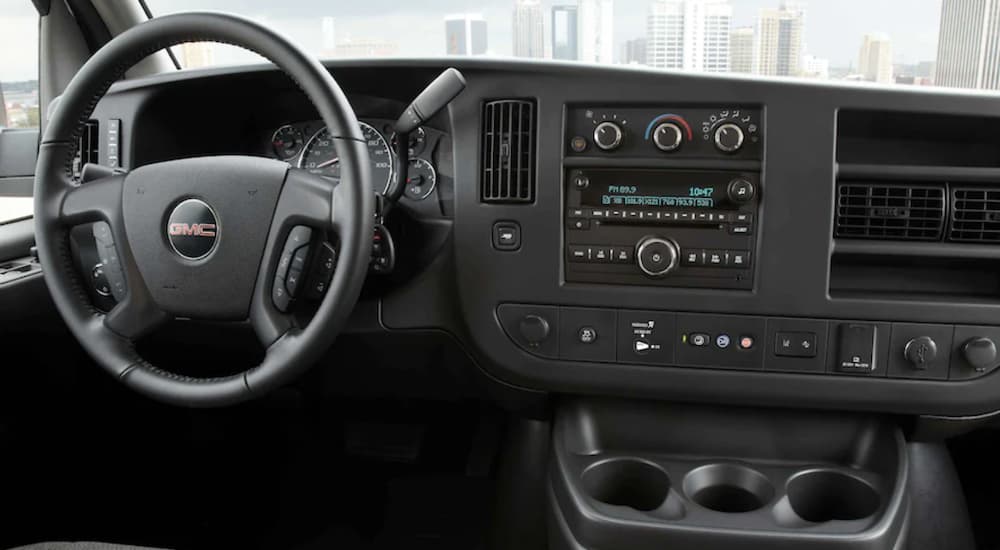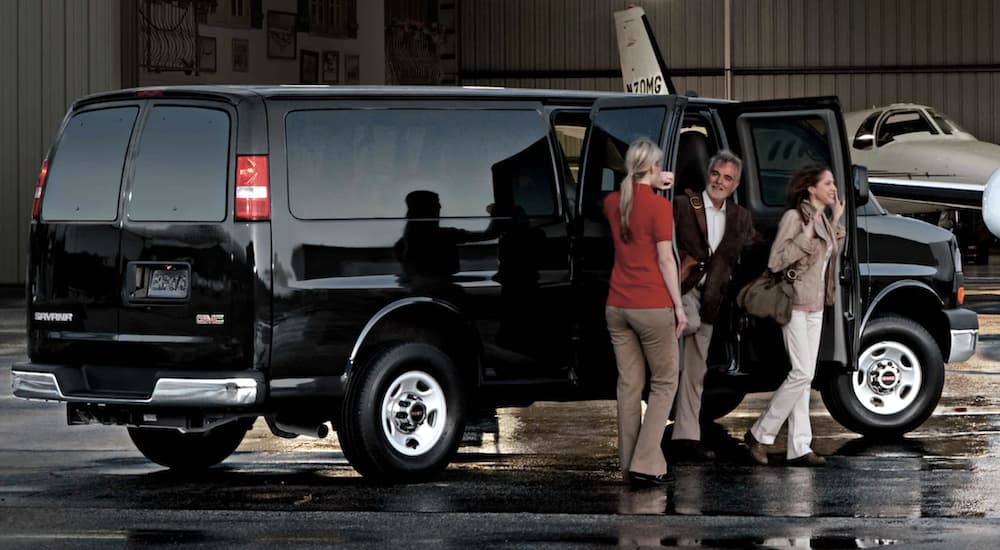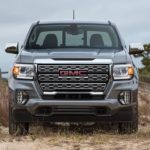The versatile Savana is one of our favorite GMC models of all time due to its sheer adaptability; from tradesmen to travelers and everyone in between, the van offers a blank automotive slate onto which each driver can write their own story. While it’s a stalwart among plumbers, electricians, and the like, few vehicles cater to the #vanlife better than the GMC Savana. As one of the most popular vans on the market, the Savana (also sold as the Chevrolet Express) is a common sight at campgrounds, festivals, and trailheads, as well as the countless internet forums dedicated to the nomadic van-based lifestyle. Of course, this should be no surprise given that it’s easily found for an affordable price at used GMC dealerships around the country.
If this sounds like a slightly more biased review than one usually finds on this site, there’s a reason for that. To paraphrase the old Hair Club for Men slogan, I’m not only a champion of GMC’s popular full-size van, but I’m also an owner. I bought my 1999 GMC Savana 1500 in the summer of 2020, following the lead of a few friends who purchased their own rigs in a bid to stave off Covid-induced boredom. These ran the gamut from a fellow Savanna 1500 to a Ford Econoline and a small 1979 Winnebago with shag carpets – on the walls – and a closet-sized bathroom built almost exclusively out of rotted wood.
Armed with overlanding apps and trusty Haynes repair manuals – all the vehicles were at least of legal drinking age – we set out to all corners of the state, finding free places to park, racking up the miles, and getting pretty handy with a camp stove in the process. What followed was one of the best summers of my life, experiencing my state like never before with a new feeling of freedom that was only interrupted by short visits home to pet my cat. While this lifestyle might not be for everyone, I thought I might recount my own experience with the Savana, sharing some insight on the advantages and disadvantages of this particular mode of travel and including some tips, tricks, and anecdotes along the way.

At Home on the Road
Though I purchased my van recently, the process actually began years before when I first started regularly browsing Craigslist, Facebook, and the like for potential candidates. Not knowing exactly what I wanted, I clicked on every van, bus, and RV I came across, imagining what it would be like to be able to just pack up and hit the road at a moment’s notice without needing to leave any of the comforts of home behind. There is no shortage of “creative” options out there, including the expected hippie paint jobs, dilapidated museum pieces, and one freak show that solved the age-old HVAC issue by installing a full-on air conditioner in the back window.
Those pursuing the #vanlife typically land on one of three distinct types of vehicles: full-size cargo vans, conversion vans, and smaller RVs. While they’re not economy cars, they all get decent enough gas mileage so that you can do some exploring without breaking the bank, as opposed to the city block-long Winnebagos favored by some vacationers. Conversion vans are simply full-size cargo vans that have been sent to third-party outfits to be upgraded with all the bells and whistles necessary to make it into a home on wheels. Many of these are low-top conversions with standard-height roofs, though, for a premium, one can opt for a high-top conversion that offers an extended roof to provide more headroom.
I was pleasantly surprised to land a 1999 low-top conversion model for $3,500, a particularly decent deal given all the upgrades that had already been performed on the van. The previous owner had installed not only a bed but also wood paneling, solar panels, a power inverter with two backup batteries, a roof-mounted fan, and a slew of questionable design flourishes (while I’m not calling anyone’s aesthetic sense into question, a poster reading “Let’s Get Lost” is a weird decoration for a motor vehicle).
These types of upgrades really make all the difference in the conversion scene, with the solar panels and inverter allowing for the type of off-the-grid adventures that had previously been unimaginable. While I like my current setup, I am intrigued by this new generation of portable power banks (like the Jackery Explorer or Anker Powerhouse) which can be hooked up to existing solar panels, their own portable array, or charged through traditional AC/DC power from your home or in-vehicle DC jack. This provides more flexibility, ensuring you won’t be left without any juice should you run into a stretch of cloudy days. The value of the roof-mounted fan should never be discounted either, as the Savana doubles as an oven within a half-hour of the sun hitting it in the morning. Running off a small trickle of power from the two storage batteries, the fan can be set to kick on at a specific temperature, ensuring comfort and air circulation throughout the night.
Perhaps most importantly, the van had been very well cared for, with previous owners storing it inside during the winter, safe from the typical New England road salt that can eat through a frame in no time. This is an important factor to consider when in the market for any used vehicle, but especially relevant when discussing a van with over 150,000 miles on the odometer. One friend actually flew to Florida to buy his Savana, with the state’s milder weather keeping the van incredibly well-preserved compared to its northern counterparts.
A Trusty Partner in Adventure
After driving to a suburb of Boston to pick up the Savana, it was love at first sight… and something of a trial by fire. On my way back home, I was blinded by the bright afternoon sun, mired in rush hour traffic, and struggling to see past the windshield in a vehicle roughly twice the size of any I’d ever driven before. I quickly adjusted to the van’s bulk, developing a good sense of just how much space I was taking up and (eventually) even parallel parking with little incident. This had been a concern of mine initially, but I was surprised by how quickly I adjusted to the new dimensions.
The specialty conversion model I ended up with had plenty of windows, making it easier to navigate than your typical white panel van. Height was another new factor to consider. While I wasn’t in danger from any low-hanging bridges, the Savana’s roof seemed surprisingly lofty at first. This was exacerbated by the roof rack and roof-mounted fan, which add a good 8-10 inches to the overall height. Well worth it for the utility factor, but an important thing to remember when approaching some drive-thru lanes.
Shortly upon returning home, I ran into my first snafu with the 20-plus-year-old van: a check engine light that I suspect had been cleared shortly before the purchase. After an initial panic, I took to the internet and cracked open the Haynes repair manual, quickly diagnosing the issue as a misfire on a specific cylinder that was easily remedied by replacing a single spark plug. I know that sounds impressive, but let’s make it abundantly clear that I’m not the most mechanically-inclined person out there. While I would probably never dream of trying to perform anything other than the simplest repair on my primary vehicle, the van wasn’t as imposing somehow. Maybe it’s because I knew that screwing something up wouldn’t mean sidelining my primary means of transportation, but it’s more than that.
The Savana just seems less intimidating than your typical car, truck, or SUV. The inner workings are easily accessed through the hood or the bulkhead inside the cabin, allowing you to reach vital components without too much work. The Haynes manual provided helpful step-by-step instructions in common terms that assume nothing about one’s mechanical savvy, giving me the confidence to at least diagnose, if not repair, most issues that arose.
In over two years of ownership, there’s been only one other real snafu (aside from the 200-plus acorn shells I found stuffed into the air filter by a particularly crafty squirrel): another misfire, this time caused by driving through a lake-sized puddle in a spontaneous mid-summer downpour. Armed with an OBD2 reader that, at $20, has already paid for itself many times over, I was able to track down the issue to a cracked distributor cap that took on water. $35 and a few scraped knuckles later, I was back on the road, imbued with the sort of confidence that comes from not handing your credit card over to an auto garage.
An Experience on Four Wheels
Over the last two years, the van has allowed me to explore my home state in a way I never had before. From dirt roads and hiking trails to friend’s backyards and the occasional seaside parking spot, the possibilities seemed endless. There are a number of overlanding apps that will direct you to free overnight parking spaces, as well as public restrooms, water sources, dumping stations, and the like. It’s thanks to these that I found myself waking up at, say, the parking lot of a famous Maine lighthouse or a secluded boat launch less than a mile from one of the state’s best beaches. It might take some time to adjust to the things that go bump in the night (or in the case of that boat launch, the terrifying howl of a fox in heat), but for someone whose sense of adventure is outweighed only by their desire to save money, it provided the perfect synthesis of the two.
The popularity of the Savana as a work truck works out quite well for those who plan to use theirs for more recreational purposes: the ubiquity of the typical white-paneled Savana among tradesmen, commercial businesses, and the like means that the van is less likely to attract unwanted attention than some of the splashier conversion models out there. This is perfect for those looking to save money with some incognito camping, finding quiet – and most importantly, free – places to park for the night. It is easy enough to accomplish this in a conversion model or RV as well, though the privacy offered by the panel van version’s lack of windows might be comforting for those traveling alone.
Lacking insulation, my Savana doesn’t see as much use in the colder months, though it does come out occasionally for late-fall and early-spring surfing sessions and doubles as a roomy shed for my boards during the winter. Insulation wouldn’t be very difficult to install should I so choose, though the interior’s wood paneling would make it a bigger undertaking than I’m down for at the moment. As we enter the one time of the year when the van isn’t necessarily the best option, I find that it’s constantly in my thoughts as I ruminate on new projects, trips, and uses for it.
This might be one reason the van lifestyle holds so much appeal for the younger generations: with the concept of a mortgage being hard to wrap your head around given the economic climate, vans provide a novel way to express that natural nesting instinct on a smaller scale. The GMC Savana is the perfect template on which to build your own nest-on-wheels, with a level of versatility, convenience, and dependability that’s cemented its position as one of the most popular full-size cargo vans on the market. While owning an older model requires some added maintenance and attention, the sheer value provided by a vehicle that doubles as a home-away-from-home makes the Savana more than just a great value: it’s an experience on four wheels.





